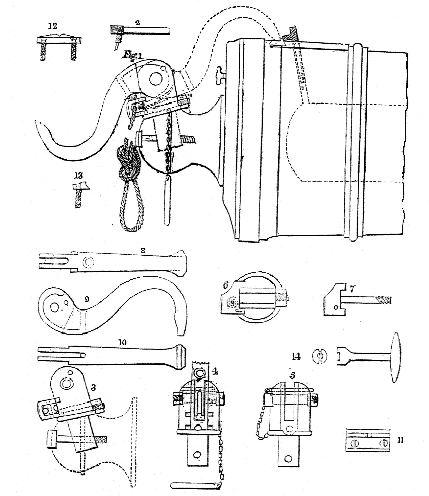The following article was originally
published in The United Service Journal , and Naval and Military Magazine. in 1831:
CAPTAIN HENRY DEHNEL, of the Royal Hanoverian
Artillery, Knight of the Guelphic Order, has invented a Percussion Lock for pieces of
Ordnance, which does much credit to his ingenuity.
Annexed is a sketch of the
invention,

The lock consists of a hammer in the form of
a swan's neck... the foot of which is circular, and revolves upon a steel bolt, which
traverses an iron block fixed in the cascabel of the gun.
The hammer moves in the
vertica1 plane of the gun's axis, performing its stroke on a small bridge, which is let in
to the vent field, and which receives the copper arm of a detonating tube. It is set in
motion by means of a rope which runs round its circular foot, and is fastened to the neck
of the hammer. The rope is directed by a little sheave placed behind the block, to the
flank of the gun, from whence the motion is given to the hammer.
EXPLANATION OF THE PLATE
Figure 1. represents the lock affixed to a
British light six-pounder, as seen from the right side.
Fig.2.
Detonating tube.
3.
lock and bolt
attached to the cascabel
4. Back of the block and
bolt, with suspending pin, the hammer being upright.
5. Front of the Block.
6. Ground plan of the
block and bolt.
7. Pulley case from
above.
8. Hammer from ditto.
9. Ditto from the
right side.
10. Ditto from below.
11. Bridge from above.
12. Back of the bridge.
13. Bridge from below.
14. Turnscrew and nut.
The principal advantages which Capt. Dehnel
ascribes to this lock are-- its certain effect, and simple and solid construction; its
firm fastening without weakening the body of the gun; the protction which its position on
the cascabel ensures to the lock; the facility which the manner in which it is attached to
the gun, affords of refixing it on the cascabel in case of accident; its capability of
construction by any common blacksmith; the ease with which it can be cleaned, and the
little expense with which it can be constructed.
Moreover, the vent
remaining free, the gun can also be fired in the usual manner
Copyright:Access Heritage Inc (formerly The Discriminating General)
Reproducing
of this article in any form is strictly forbidden.
Support the
growth of this site by making your book purchases here:
Barnes&Noble.com (United States) :

